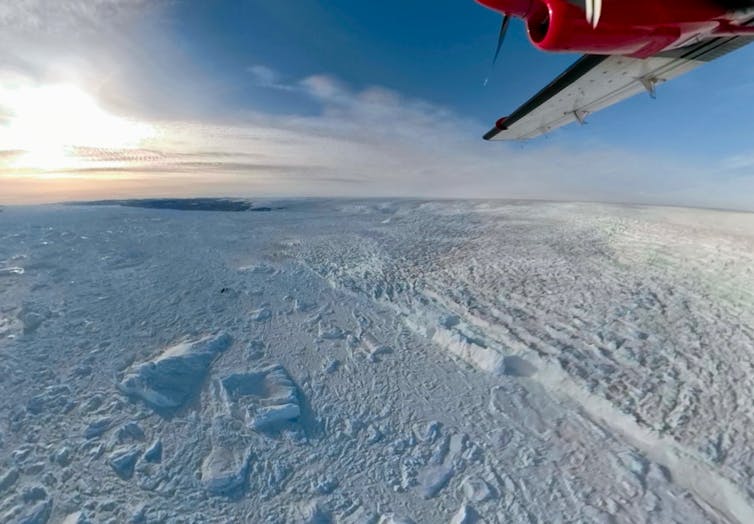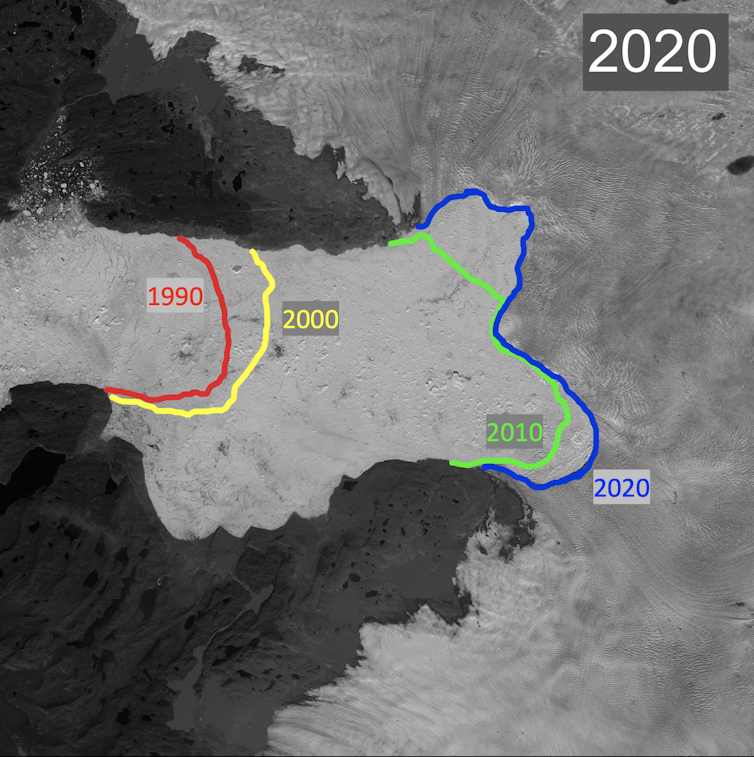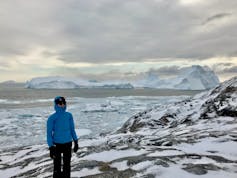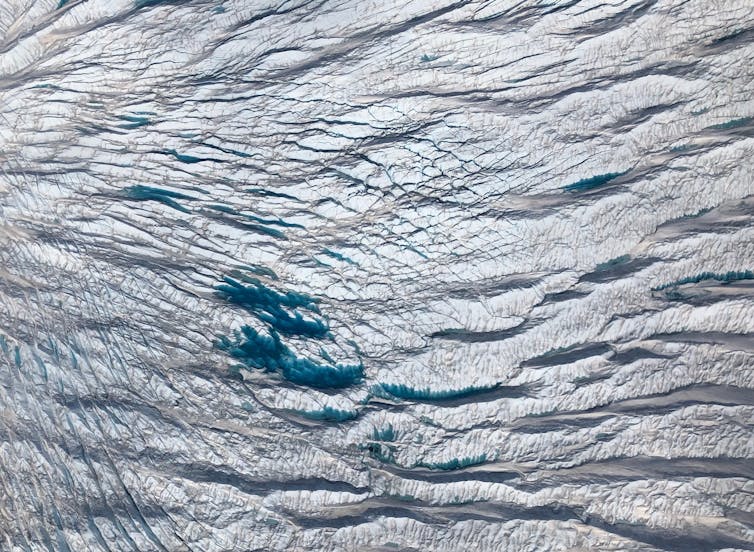Shrinking glaciers have created a new normal for Greenland's ice sheet – consistent ice loss for the foreseeable future
- Written by Michalea King, Postdoctoral Climate Science Researcher, The Ohio State University
Greenland is the largest island on Earth, and about 80% of it is covered by a giant sheet of ice[1]. Slowly flowing glaciers connect this massive frozen reservoir of fresh water to the ocean, but because of climate change, these glaciers are rapidly retreating.
I’m an earth scientist[2] who studies how changes to Greenland’s glaciers affect the stability of the ice sheet as a whole. Healthy glaciers are stable in size and shape and act as drains for the ice sheet, transporting ice into the sea. They maintain a balance where the ice added each year roughly equals the ice lost to the sea.
But because of warming caused by climate change, that dynamic has changed.
For years, scientists have watched as glaciers around the world retreat. But our research has found that the glaciers along the edge of Greenland have retreated so much that they no longer keep the ice sheet that feeds them in balance[3].
As the glaciers retreat up valleys, they flow faster and bring more ice from inland to the sea. Imagine a traffic jam: When a highway is jampacked with cars – or ice – it flows slowly. But as the jam or glacier gets smaller, the number of cars, or the amount of ice, that can flow by in a given time increases.
Greenland’s ice sheet is now out of balance. The new normal is an annual overall loss of ice[4].
 The place where glaciers meet the sea – called the calving front – is important for the stability of the entire ice sheet. Jakobshavn Glacier has been retreating for decades.
Michalea King, CC BY-ND[5]
The place where glaciers meet the sea – called the calving front – is important for the stability of the entire ice sheet. Jakobshavn Glacier has been retreating for decades.
Michalea King, CC BY-ND[5]
Changes at the edge, consequences for the whole
Ice sheets are formed when snowfall accumulates over thousands of years and compresses into layers upon layers of ice. But ice is not a perfectly rigid material – it behaves kind of like an extra-thick yet brittle honey[6].
Once an ice sheet becomes tall enough, the ice begins to flow outward because of its own weight. This ice is funneled down valleys toward the ocean, forming fast–flowing outlet glaciers. These glaciers can move as much as 10 miles[7] per year.
Although glaciers comprise only a narrow region at the edge of the ice sheet, they play a huge role in controlling how rapidly ice is drained from the sheet into the ocean. Generally, a glacier that extends a long distance through a valley will move more slowly[8] and drain less ice from the ice sheet than if it were shorter.
Most of Greenland’s glaciers end at the sea, where ocean water melts and weakens the ice until it breaks off in pieces that dramatically fall into the North Atlantic. If ice is lost at the front of the glacier faster than it is replenished by upstream ice, the glacier will recede inland. This is called glacial retreat.
Retreat not only shortens the length of the glacier but also reduces the friction between the ice and surrounding valleys[9]. With less surface area of ice touching the ground, the ice can flow faster. Much like a shrinking traffic jam, sustained glacier retreat results in faster-flowing glaciers that drain the ice sheet above more rapidly[10].
 The blue line shows the current boundary between the Jakobshavn Glacier (right side, light gray) and the floating ice (center, white) between the valley walls (top and bottom, dark gray). The other colored lines show where this boundary was in previous years.
Michalea King, CC BY-ND[11]
The blue line shows the current boundary between the Jakobshavn Glacier (right side, light gray) and the floating ice (center, white) between the valley walls (top and bottom, dark gray). The other colored lines show where this boundary was in previous years.
Michalea King, CC BY-ND[11]
A persistent state of loss
Ocean and air temperatures have strong effects on glaciers. Both ocean[12] and air temperatures[13] are rising.
For Greenland’s glaciers, the warming ocean is the biggest cause of glacial retreat. On average the glaciers have retreated about 3 kilometers since the mid-1980s[14], with most of this retreat occurring between 2000 and 2005.
My colleagues and I used thousands of satellite images to measure changes in length, thickness and flow speed of Greenland’s glaciers. With this information, we found two important things: Glacial retreat is accelerating, and the ice sheet is losing an astonishing – and also increasing – amount of ice each year.
 The glaciers have retreated so much that the amount of ice they lose exceeds how much ice is added each year.
Santiago de la Peña, CC BY-ND[15]
The glaciers have retreated so much that the amount of ice they lose exceeds how much ice is added each year.
Santiago de la Peña, CC BY-ND[15]
Our team found that today, the glaciers drain 14% more ice from the ice sheet annually[16] – approximately 500 billion metric tons – than they did on average between 1985 and 1999. This faster flow is causing the ice sheet that covers most of Greenland to shrink, but it has also changed the dynamic of the entire system.
The ice sheet is now in a new, unbalanced state of persistent mass loss. Before the year 2000, ice loss roughly equaled the ice added from snowfall, so the ice sheet was stable. Now, ice mass losses consistently exceed mass gains – even in the coolest years of relatively high snow accumulation. The glaciers used to act as an important traffic jam, keeping ice loss in check. Now, however, traffic flows more freely and the ice is able to more easily flow away from the ice sheet.
Unfortunately, warmer air temperatures have also increased surface melt[17], resulting in less snow now accumulating on Greenland. Given all these factors, my colleagues and I now estimate that the ice sheet may see a mass gain year only once a century[18].
 Eventually, the ice sheet will become completely landlocked, and only ice melt and snow accumulation will determine then whether it grows or disappears completely.
Michalea King, CC BY-ND[19]
Eventually, the ice sheet will become completely landlocked, and only ice melt and snow accumulation will determine then whether it grows or disappears completely.
Michalea King, CC BY-ND[19]
In serious trouble, but not yet doomed
Our study showed how widespread retreat drove both an increase in glacier discharge and a shift to persistent ice sheet mass loss. But this doesn’t mean the ice sheet is doomed. Continued retreat and further increases in discharge are limited by topography.
[Deep knowledge, daily. Sign up for The Conversation’s newsletter[20].]
Over the next several centuries, the glaciers may retreat onto higher ground and eventually form a completely landlocked ice sheet with minimal flow[21] – essentially a large chunk of ice sitting on top of Greenland with no glaciers to drain it. Under this future scenario, the balance of the ice sheet would be determined only by surface changes – snow accumulation and surface melt. This loss of ice would equal meters of sea level rise[22].
At this point, the fate of the ice sheet simply depends on whether it is melting faster than it grows from snowfall. In a warm world where climate change is not addressed, the ice sheet will slowly melt and ultimately disappear. But if climate change is controlled and cooler temperatures are maintained for a prolonged period, it is possible that the Greenland ice sheet could regrow. That day may be hundreds of years into the future, but it is actions made today that will decide the fate of Greenland’s ice sheet.
References
- ^ giant sheet of ice (nsidc.org)
- ^ I’m an earth scientist (scholar.google.com)
- ^ keep the ice sheet that feeds them in balance (doi.org)
- ^ annual overall loss of ice (doi.org)
- ^ CC BY-ND (creativecommons.org)
- ^ extra-thick yet brittle honey (doi.org)
- ^ 10 miles (doi.org)
- ^ will move more slowly (doi.org)
- ^ friction between the ice and surrounding valleys (doi.org)
- ^ drain the ice sheet above more rapidly (doi.org)
- ^ CC BY-ND (creativecommons.org)
- ^ ocean (doi.org)
- ^ air temperatures (doi.org)
- ^ 3 kilometers since the mid-1980s (doi.org)
- ^ CC BY-ND (creativecommons.org)
- ^ 14% more ice from the ice sheet annually (doi.org)
- ^ increased surface melt (doi.org)
- ^ only once a century (doi.org)
- ^ CC BY-ND (creativecommons.org)
- ^ Sign up for The Conversation’s newsletter (theconversation.com)
- ^ landlocked ice sheet with minimal flow (doi.org)
- ^ meters of sea level rise (doi.org)
Authors: Michalea King, Postdoctoral Climate Science Researcher, The Ohio State University

